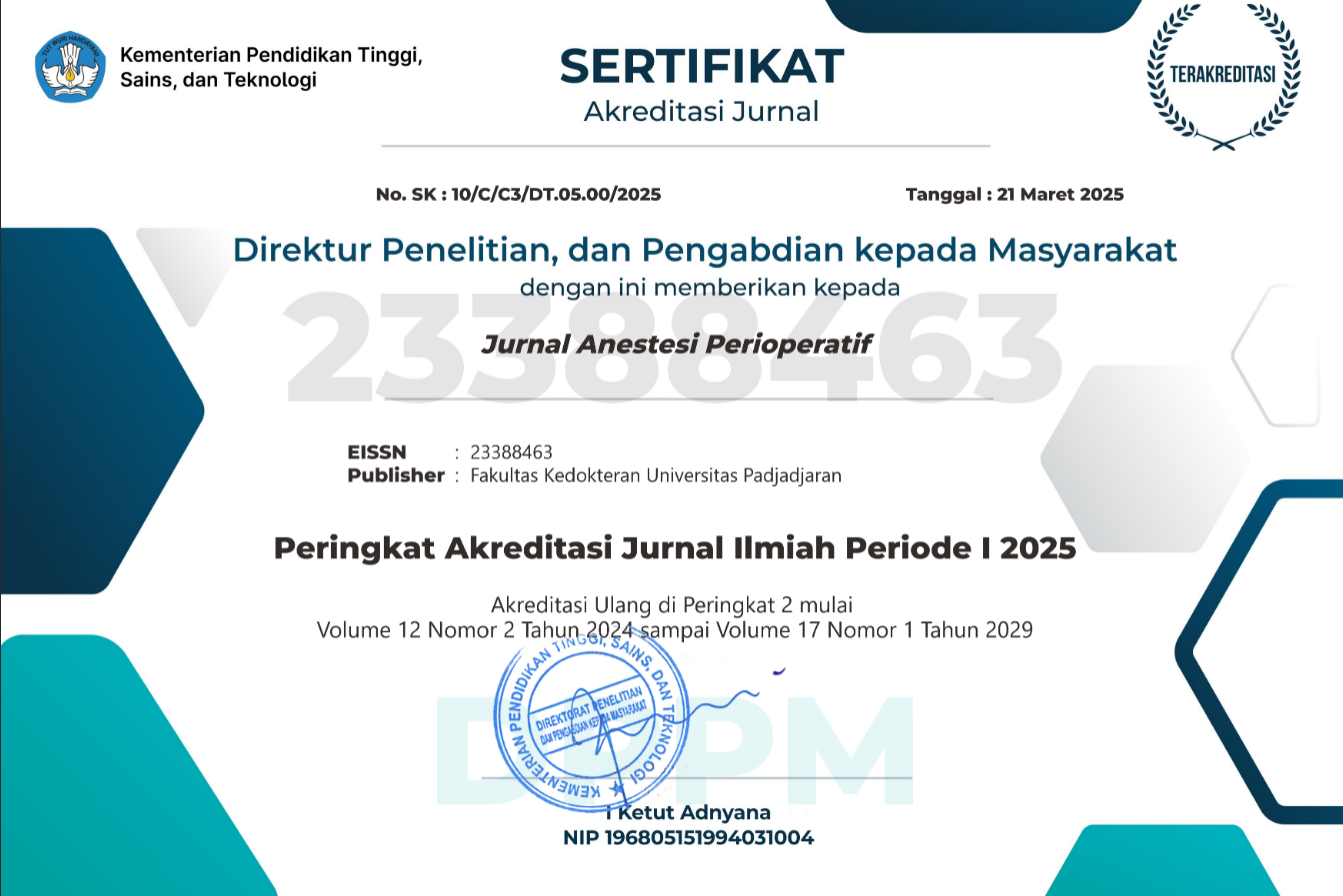Perbandingan Pemberian Efedrin 30 mcg/kgBB dengan Efedrin 70 mcg/kgBB Intravena terhadap Skala Nyeri dan Efek Hipotensi pada Penyuntikan Propofol di Rumah Sakit Dr. Hasan Sadikin Bandung
Abstract
Penyuntikan propofol menyebabkan nyeri dan perubahan tekanan darah. Efedrin merupakan obat yang digunakan untuk mengurangi efek yang tidak diinginkan saat penyuntikan propofol. Penelitian ini bertujuan membandingkan pemberian efedrin 30 mcg/kgBB intravena dengan efedrin 70 mcg/kgBB intravena terhadap skala nyeri dan efek hipotensi pada penyuntikan propofol. Penelitian dilakukan di Rumah Sakit Dr. Hasan Sadikin Bandung pada bulan September hingga November 2015 terhadap 60 orang pasien dengan American Society of Anesthesiologist (ASA) kelas I dan II, usia 18 hingga 60 tahun yang menjalani operasi elektif dengan anestesi umum secara uji acak kontrol buta ganda. Pasien dibagi menjadi dua kelompok, 30 orang menerima efedrin 30 mcg/kgBB dan 30 orang menerima efedrin 70 mcg/kgBB, diberikan 1 menit sebelum penyuntikan propofol. Analisis statistik menggunakan uji Mann-Whitney. Hasil penelitian menunjukkan skala nyeri pada kelompok efedrin 30 mcg/kgBB dan efedrin 70 mcg/kgBB tidak berbeda bermakna (p>0,05), dan perubahan tekanan darah sistole dan diastole efedrin 30 mcg/kgBB dengan efedrin 70 mcg/kgBB berbeda bermakna (p<0,05). Simpulan, efedrin 30 mcg/kgBB dan efedrin 70 mcg/kgBB menurunkan skala nyeri saat penyuntikan propofol, dan efedrin 70 mcg/kgBB mencegah efek hipotensi lebih baik dibanding dengan efedrin 30 mcg/kgBB.
Comparison of 30 mcg/kgBW and 70 mcg/kgBW Intravenous Ephedrine on Pain Scale and Hypotension After Propofol Injection in Dr. Hasan Sadikin General Hospital Bandung
Injection of propofol causes pain and blood pressure changes. Propofol can cause pain at the injection site and decrease the blood pressure while ephedrine is considered to minimize those adverse effect. The purpose of the study was to compare the effects of 30 mcg/kgBW and 70 mcg/kgBW intravenous ephedrine on pain score and blood pressure changes after propofol injection. This double-blind randomized control trial was conducted in Dr. Hasan Sadikin General Hospital Bandung, September to November 2015, on 60 patients with American Society of Anesthesiologist (ASA) physical status I and II, aged 18 to 60 years old. Patients were divided into 2 groups of 30 persons; the first group received 30 mcg/kgBW ephedrine and the second group received 70 mcg/kgBW ephedrine one minute before propofol injection. Statistical analysis was performed using the Mann-Whitney test. This study showed no significant difference in pain score between the group that received 30 mcg/kgBW ephedrine and 70 mcg/kgBW (p>0,05), but there were significant differences in blood pressure changes (p<0,05). It can be concluded that 30 mcg/kgBW and 70 mcg/kgBW ephedrine could reduce pain score following propofol injection with 70 mcg/kgBW ephedrine reduces the hypotension effect better than the 30 mcg/kgBW dose.
Keywords
Full Text:
PDFReferences
Butterworth JF, Mackey DC, Wasnick JD. Intravenous anesthetics. Dalam: Butterworth JF, Mackey DC, Wasnick J, penyunting. Morgan and Mikhail’s clinical anesthesia. Edisi ke-5. Philadelphia: McGraw–Hill; 2013. hlm. 175–88.
Vuyk J, Sitsen E, Lubarsky DA, Reekers M. Intravenous anesthetics. Dalam: Miller RD, penyunting. Miller’s anesthesia. Edisi ke-8. Philadelphia: Elsevierchurchill Livingstone; 2014. hlm. 821–32.
Nishiyama T. How to decrease pain at rapid injection of propofol: effectivenes of flurbiprofen. Anesthesiology. 2005;19(4): 273–6.
Liljeroth E. Pain induced by propofol-clinical studies on drug composition and administration. Sweden: Malmo University Hospital; 2007.
Khezri MB, Kayalha H. The effect of combined ephedrine and lidocaine pretreatment on pain and hemodynamic changes due to propofol injection. Acta Anaesthesiologica Taiwanica. 2011;49:54–8.
Singh. V. Prophylactic use of ephedrine to attenuate the haemodynamic responses to propofol: aprospective randomized, double blind comparative trial. Indian Anaesthesiol. 2005;49(5):409–2.
Sundarathiti P, Boonthom N, Chalacheewa T, Jommaroeng P, Rungsithiawan W. A comparison of propofol–LCT with propofol–LCT/MCT on pain of injection. J Med Assoc Thai. 2007;90(12):83–8.
Golisa CH, Charalabopoulos A, Stagikas D, Charalabopoulos K, Batistaou A. The kinin system – bradykinin: biological effects and clinical implications. Multiple role of the Kinin System-Bradykinin. Hippokratia. 2007;11(3):124–8.
Yamakage M, Iwasaki S, Satoh JI, Namiki A. Changes in concentration of free propofol by modification of the solution. Anesth Analg. 2005;101:385–8.
Morgan GE, Mikhail MS, Murray MJ, penyunting. Pain management. Clinical anesthesiology. Edisi ke-4. New York: Mc Graw-Hill; 2006.
Rathmel JP, Rosow CE. Intravenous sedatives and hypnotics. Dalam: Stoelting FP, Rathmell JP, Shafer SC, penyunting. Pharmacology & physiology in anesthetic practice. Edisi ke-4. Philadelphia: Lippincott Williams & Wilkins; 2006. hlm. 160–3.
Ohmizo H, Obara S, Iwama H. Mechanism of injection pain with long– and long–medium chain triglyceride emulsive propofol. Can J Anaesth. 2005;52:595–9.
Ebert T. Autonomic nervous system pharmacology. Dalam: Hemmings H, Egan T, penyunting. Pharmacology and physiology for anesthesia foundation and clinical application. Edisi ke-1. Philadelphia: Elsevier Saunders; 2013. hlm. 218–20.
Rathmel JP, Rosow CE. Intravenous sedatives and hypnotics. Dalam: Stoelting FP, Rathmell JP, Shafer SC, penyunting. Pharmacology & physiology in anesthetic practice. Edisi ke-4. Philadelphia: Lippincott Williams & Wilkins; 2006. hlm. 160–3.
DOI: https://doi.org/10.15851/jap.v5n3.1164
Article Metrics
Abstract view : 2685 timesPDF - 855 times
This Journal indexed by

JAP is licensed under a Creative Commons Attribution-NonCommercial 4.0 International License
View My Stats



